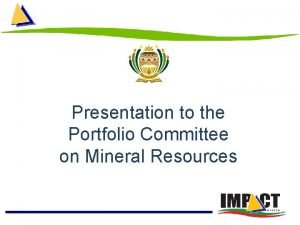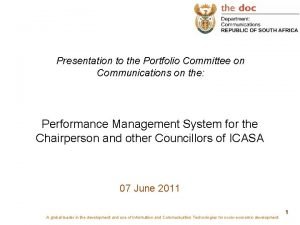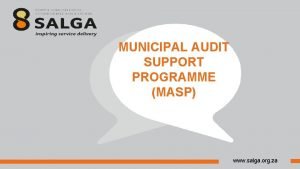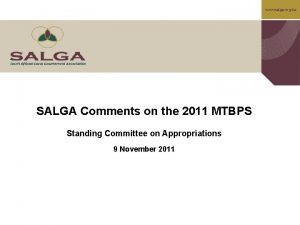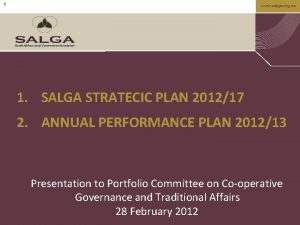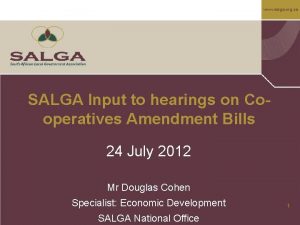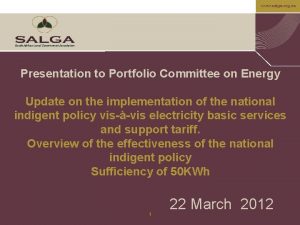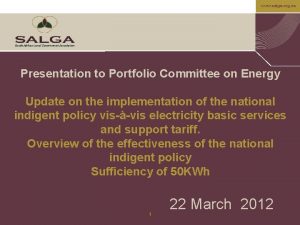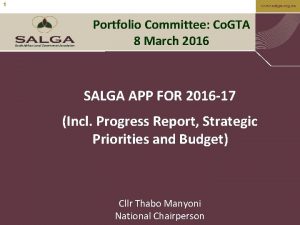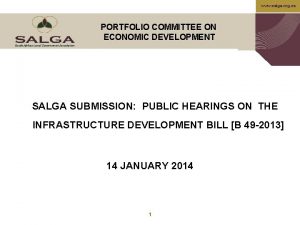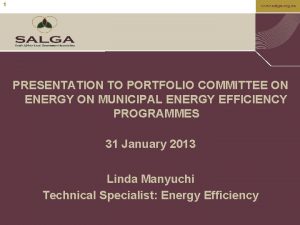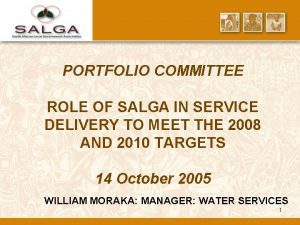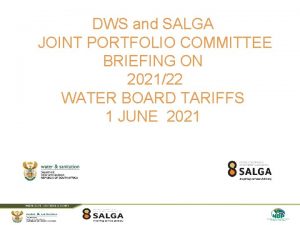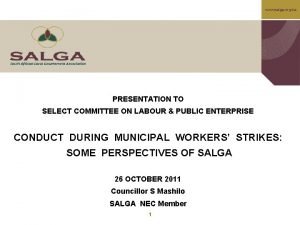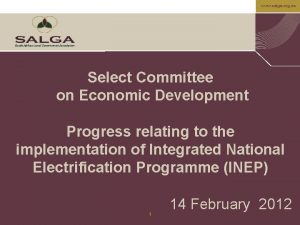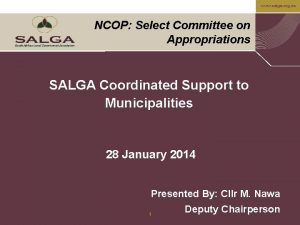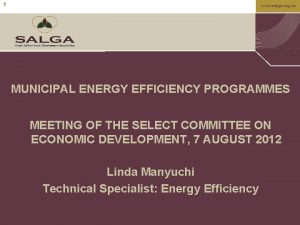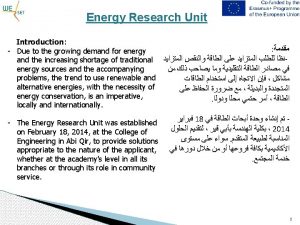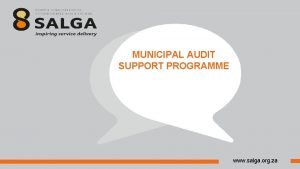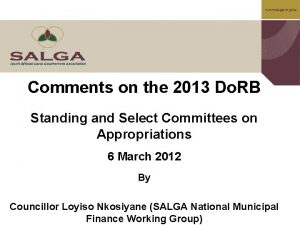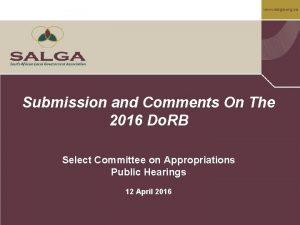www salga org za Portfolio Committee on Energy

































- Slides: 33

www. salga. org. za Portfolio Committee on Energy Impact of the MYPD 3 Determination on Municipalities 24 May 2013

www. salga. org. za Introduction q The discussion points for today's presentation originally stemmed from a 16% electricity tariff increase proposed by Eskom. Subsequently, Eskom was only allowed a tariff increase of 8%. q This has resulted in much of the arguments/issues previously raised being automatically addressed by way of the reduced increase. q However, SALGA would like to use this opportunity to brief the committee on further issues pertaining to electricity tariffs as well as provide feedback on previously discussed matters.

www. salga. org. za Presentation Content The presentation will talk around the following key matters: - 1. 2. 3. Reduced electricity tariff increase 4. 5. Effect this has on municipalities in terms of service delivery 6. 7. Factoring in of ADAM 8. FBE and FBAE implementation challenges and mechanisms to address such including Indigent Register and Policy Challenges Expected projections on surcharges by municipalities Reasons for substantial electricity pricing variation at municipalities Infrastructure maintenance and development including skills and capability development Issues around non-payment by municipalities to Eskom, e. g. Matlosana Municipality

www. salga. org. za REDUCED ELECTRICITY TARIFF INCREASE – 8%

www. salga. org. za Reduced Electricity Tariff Increase q Only 50% of Eskom’s requested tariff increase was approved by the National Energy Regulator of South Africa i. e. 8% and not 16%. q SALGA would like to place on record their appreciation to key decision makers as they have taken due cognisance of the impacts of the higher than average tariff increases and have limited the burden placed on the citizens/business/industry of the country. q HOWEVER, of concern is the ability of Eskom to operate a sustainable network with the reduced increase. NERSA/Eskom must quantify the direct and indirect consequences to the Eskom business as a result of the reduced increase. q This report must be made available to SALGA/other stakeholders. The associated risks need to be understood. The short term tariff relief could have drastic long term economic effects should it be found that security of supply is compromised. q Where it is noted that there is risk in terms of security of supply, this must be addressed by way of suitable solutions without affecting the increase applicable to the municipal tariffs. The reduced increase was well received by municipal customers and it will go a long way in sustaining the local economies which are vital for municipalities to thrive.

www. salga. org. za EXPECTED PROJECTIONS ON SURCHARGES BY MUNICIPALITIES TO ADDRESS POSSIBLE FINANCIAL SHORTFALLS

www. salga. org. za Expected Projections on Surcharges by Municipalities to Address Possible Financial Shortfalls LOAD SHEDDING q Media reports and recent Eskom correspondence raised alarm bells on the issue surrounding load shedding. Whilst it is known that the countrywide impacts are broadly negative, of particular note is the loss of revenue to municipalities. q Current municipal tariffs are structured to attain revenue recovery by means of electricity sales. Load shedding forces municipalities to reduce their sales volumes which impact the bottom line and in-turn reduce the finances available for carrying out municipal functions ( i. e. repairs, maintenance, ability to cross subsidy etc. ) q A further issue that leads to declining sales is the promotion of energy efficiency. q Whilst the principle of saving energy is fully supported by SALGA, the reality is that the revenue of the municipalities will decline as a result. • REDUCED SALES VOLUMES = REDUCED REVENUE

www. salga. org. za Expected Projections on Surcharges by Municipalities to Address Possible Financial Shortfalls (Cont. . ) q The graph aside shows the declining trend in terms of electricity sales volumes from 2009 to 2012 in e. Thekwini. q It is evident that customers are using less electricity. This is a profile of a leading metro with good economic stimulation, the profile of a smaller municipality will look much worse. q Mitigation steps to address the financial shortfalls have to be implemented to ensure sustainability of municipalities. q The mitigation steps in terms of dealing with the loss of revenue as a result of reduced sales volumes are as follows: 1. INTRODUCING ROLLING CONTINGENCY RESERVES WITHIN BUDGETS 2. INTRODUCTION OF MUNICIPAL SURCHARGES 0% -0. 4% -0. 5% -1. 2% 2009 2010 2011 2012 The graph depicts the declining sales trend as experienced in e. Thekwini Municipality Higher than average tariff increases are also driving customers to use less electricity

www. salga. org. za Expected Projections on Surcharges by Municipalities to Address Possible Financial Shortfalls (Cont. . ) INTRODUCING ROLLING CONTINGENCY RESERVE WITHIN BUDGETS q Suitable provision can be made via the tariff approval process to allow municipalities to include within their budgets a rolling contingency reserve that will deal with shortfalls as a result of reduced electricity sales volumes q Municipalities can quantify the possible loss as a result of the above mention factors and budget for this loss accordingly. q Municipal sustainability is heavy dependant on the electricity business. As an example In the case of e. Thekwini, the electricity unit accounts for almost 35% of the cities total budget and contributes between 5 -8% of its electricity sales revenue to the city’s overall budget income in terms of yearly contributions. q In order to make this proposal work, NERSA needs to be in favour and allow for this budgeting mechanism within the tariff approval process. Further, suitable policy is required.

www. salga. org. za Expected Projections on Surcharges by Municipalities to Address Possible Financial Shortfalls (Cont. . ) INTRODUCING MUNICIPAL SURCHARGES q Another mechanism to protect municipal revenue is to raise surcharges. Surcharges are purely designed to bridge the financial gap between what was budgeted for versus what is received. The graph below highlights the principle : HOW IT WORKS • The surcharge will only apply where a municipality is unable to recover its full budgetary requirement via its tariff structures Total Revenue Requirement Municipality B A C D E Revenue from Sales Revenue from Surcharges • Surcharges may not be applicable to all municipalities and will only apply to those that cannot raise the necessary funds - Municipality B, C, E as an example. • Surcharges may be raised in line with the Municipal Fiscal Powers and Functions Act, 2007 (Act No 12 of 2007)

www. salga. org. za Expected Projections on Surcharges by Municipalities to Address Possible Financial Shortfalls (Cont. . ) q The raising of a surcharge may make certain cities more expensive to operate in and can possibly drive away business and industries. Surcharges need to be carefully regulated (in line with the Municipal Fiscal Powers and Functions Act, 2007 (Act No 12 of 2007) As an example, should e. Thekwini want to raise a surcharge to cater for a 1% drop in sales, they would have to recover a total of R 100 Million per annum from surcharges. This is equivalent to charging all business customers in the city an additional fixed charge of R 200 per month over and above their normal electricity accounts. WAY FORWARD IN TERMS OF PROTECTING MUNICIPAL REVENUE q Mitigation steps in line with the above, needs to be considered to ensure sustainability of municipalities. In moving forward, NERSA must investigate the above mentioned strategies and propose a mechanism on how it will be incorporated within the current tariff approval process and provide suitable policy.

www. salga. org. za REASONS FOR SUBSTANTIAL ELECTRICITY PRICING VARIATION AT MUNICIPALITIES

www. salga. org. za Reasons for Substantial Electricity Pricing Variation at Municipalities § Electricity prices are based on financial requirements and budgets. In essence all municipalities have different financial needs and this ultimately dictates the prices. § Furthermore, the sales profile of a municipality is a major driving factor in determining prices. These are all different among municipalities and therefore the reality is that there will be pricing variation among municipalities. § These principles can be demonstrated by the following simplified example: Municipality A Total Budget: Total Sales: Average price: R 1 000 000 k. Wh R 1/k. Wh Municipality B Total Budget: Total sales: Average Price: R 1 000 2 000 k. Wh R 0. 5/kwh § Individual circumstances of municipalities will dictate the average prices charged. The cross subsidy framework of each municipality and required revenue also affect the prices.

www. salga. org. za Reasons for Substantial Electricity Pricing Variation at Municipalities (Cont…) q Prices may vary however there is an opportunity to have similar tariff structures within municipalities that cater for the different customer segments i. e. Business, Residential, Industrial, Time of Use etc. q Currently tariff structures are not uniform amongst all municipalities but the Metros are better aligned with each other and with industry norms. q It is generally smaller municipalities that don’t offer a range of tariffs as a result of not having suitable skills to design, implement and maintain the tariff structures. Greater engagement is required with NERSA in this regard q There is also great misalignment between Eskom and municipalities’ prices. Municipalities are in most cases trying to align their prices closer to Eskom prices. q However, it is difficult to achieve the above in the current context……

www. salga. org. za Reasons for Substantial Electricity Pricing Variation at Municipalities (Cont…) MUNICIPAL AND ESKOM TARIFF MISMATCH q There is currently a mismatch between Eskom and Municipal tariff structures. This leads to a situation where a similar voltage customer in an Eskom area of supply will enjoy cheaper tariff rates when compared to a customer embedded within a municipal boundary. q This enables Eskom to enjoy an unfair competitive advantage and allows them to attract business and industries to their areas of supply as a result of them offering cheaper electricity tariffs. q One of the reasons for this mismatch is as a result of municipal customers not being allowed to purchase electricity from Eskom Transmission at the same rate as Eskom Distribution. q This is unfair and if Eskom distribution is operating under a separate distribution license condition, then Eskom Distribution and Distributor Municipalities should have access to similar purchasing tariffs (i. e. Eskom Transmission) and this will allow for the better 15 alignment of Eskom and Municipal tariffs.

www. salga. org. za Reasons for Substantial Electricity Pricing Variation at Municipalities (Cont. . ) MUNICIPAL AND ESKOM TARIFF MISMATCH The figure below highlights the current scenario as well as the proposed. The proposed will ensure that Eskom Distribution and distributor municipalities are treated in a similar fashion ensuring minimal tariff mismatching. 16

www. salga. org. za EFFECT THIS HAS ON MUNICIPALITIES IN TERMS OF SERVICE DELIVERY

www. salga. org. za Effect this has on Municipalities in terms of Service Delivery q Service delivery and carrying out maintenance is hinged on 2 important criteria: - q FINANCIAL SUSTAINABILITY § The municipality has to be financially sustainable in order to carry their service delivery charter. The electricity supply industry is volatile and ensuring financial sustainability within a municipal environment can be attained should we steer our thinking in line with the introduction of contingency reserves and/or surcharges as previously explained. q ATTRACTING AND RETAINING SUITABLE SKILLS § There also has to be suitable skills within a municipal environment to deliver on the service delivery charter. Attracting suitable technical skills to a municipal environment competes directly with Eskom and private industry. § There has to be alignment in terms of salary scales between Eskom/private industry & municipalities in order for municipalities to stand a chance of attracting and retaining skills. § Currently, it is extremely difficult to attract and retain suitable skills in a municipal environment. Policy intervention is required to help normalize this difficulty.

www. salga. org. za INFRASTRUCTURE MAINTENANCE AND DEVELOPMENT INCLUDING SKILLS AND CAPABILITY DEVELOPMENT

www. salga. org. za Infrastructure Maintenance and Development including Skills and Capability Development q During the long period of uncertainty regarding future ownership of distribution assets, there has been a significant underinvestment in infrastructure. – Municipalities were reluctant to invest in infrastructure in a situation where there was no certainty regarding the future of such investment. q This added to inherited maintenance backlogs that also accumulated as a result of the country’s prioritization of extension of infrastructure to the unserved rather than focusing on maintaining infrastructure that served a minority. – A study done by Electricity Distribution Industry Holdings (EDIH) in 2008 estimated that the backlog was R 27 billion growing at R 2, 5 billion per annum.

www. salga. org. za Infrastructure Maintenance and Development including Skills and Capability Development (Cont…) q The deteriorating state of the electricity distribution infrastructure is one of SALGA’s serious concerns as it negatively affects service delivery at local level. – Given this concern we will continue and strive to rigorously work with the Department of Energy , NERSA and other key stakeholders to ensure investment in electricity distribution infrastructure coupled with maintenance and refurbishment. q The 2011 SALGA National Conference resolved to lobby for the: – Establishment of a National Municipal Infrastructure Refurbishment Fund that will to provide for the rehabilitation of municipal infrastructure at the required scale (This fund should be used to leverage private sector investment). – Establishment of national GIS based databases and national programmes to collect data and manage information on an on-going basis on the state of infrastructure.

www. salga. org. za Infrastructure Maintenance and Development including Skills and Capability Development (Cont. . ) q In general there is a shortage of skills in the engineering sector – Metro’s have an ability to attract and retain specialised engineering skills, however even Metro’s tend to be out-competed by the private industries – We acknowledge that small municipalities face a severe challenges in terms of attracting and retaining skilled resources q In an effort to assist smaller municipalities with the skills gap, the following is being done: – SALGA has initiated a businesses-adopt-a-municipality programme. – We are also looking at Metros partnering with; and supporting smaller municipalities.

www. salga. org. za FACTORING IN OF ADAM

www. salga. org. za Factoring in of ADAM q The Electricity Distribution Industry (EDI) developed a significant backlog over the last couple of years in terms of electricity distribution related asset maintenance, refurbishment and strengthening. q SALGA therefore, welcomes and supports the launch of the Approach to Distribution Asset Management (ADAM) project that has been launched in line with Strategic Integrated Projects (SIPs) 6 and 10 of the Presidential Infrastructure Coordinating Commission’s (PICCs) National Infrastructure Plan. q The total Approach to Distribution Asset Management (ADAM) pilot project allocation for 2013/14 to 7 municipalities (including 2 Metros ) is R 320 million. – This should be seen as a start of addressing the EDI’s infrastructure backlog. – The Do. E should also clarify the application process or guidelines as to how this funding should be spent.

www. salga. org. za ISSUES AROUND NON-PAYMENT BY MUNICIPALITIES TO ESKOM, e. g. CITY OF MATLOSANA MUNICIPALITY

www. salga. org. za Issues around non-payment by Municipalities to Eskom, e. g. City of Matlosana Municipality q On 19 March 2013 SALGA convened an urgent meeting with affected municipalities to explore alternative mechanisms to resolve the non-payment of Eskom’s Bulk electricity Accounts. • Challenges raised by municipalities included but not limited to the following - – Cash Flow problems due to Declining Revenue Base; – Distribution Losses (Technical and Theft related); – Ageing Infrastructure; – Incorrect Billing due Meter reading problems; – Incorrect Tariffs; – High Rate of Interest on Arrears charged on Eskom accounts; – Eskom not willing to invest in upgrades due to municipal arrears as well as massive Deposit Rates charged for upgrades; – Eskom’s Maximum Demand penalties after electricity shutdown; – Active deceased accounts.

www. salga. org. za Issues around non-payment by Municipalities to Eskom, e. g. City of Matlosana Municipality (Cont…) q Another contributing factor is the amount owed to municipalities – According to National Treasury figures, the aggregate municipal consumer debts were R 83. 7 billion as at 31 December 2012. – National and provincial government debt accounted for 5. 4 % or R 4. 5 billion of the total amount. – At R 52. 5 billion, (62. 7 %) households accounted for the largest proportion of consumer debt.

www. salga. org. za Issues around non-payment by Municipalities to Eskom, e. g. City of Matlosana Municipality (Cont…) q How is SALGA assisting municipalities in finding a permanent solution? – On 28 March 2013, SALGA engaged Eskom on extending the outstanding bulk electricity account settlement window period (to create an enabling environment for municipal cash flow recovery). q The SALGA / Eskom meeting recommended the following actions: – Eskom to look into the issue of varying interest rates on municipal bulk arrear electricity accounts and will seek to adopt a common approach in determining the repayment period of arrears on a case-by-case basis based on proven affordability. – A special Eskom team will look into the Notified Maximum Demand (NMD) penalties taking into considerations economic growth / infrastructure upgrade needs of municipalities. – Eskom will further explore the formalization of cooperation with municipalities on Demand Side Management (DSM) and Integrated Demand Management (IDM) projects.

www. salga. org. za Issues around non-payment by Municipalities to Eskom, e. g. City of Matlosana Municipality (Cont…) q SALGA is also assisting and supporting municipalities with the following: – Financial and Contract Management training for municipal officials; – Focussing on customers that struggle to afford electricity; – Focussing on government, agricultural, industrial, mining and commercial customers with overdue debt of more than R 10 000; – Development of Cost Recovery Strategies; – Reviewing Credit Control Policies to ensure risk mitigation relating to customer payments; – Addressing Indigent Policies in line with Free Basic Services policies; – Deploying the adopt-a-municipality programme to affected municipalities; – Ensuring regular Reporting to National Treasury on the status of municipal debt.

www. salga. org. za FBE AND FBAE IMPLEMENTATION CHALLENGES AND MECHANISMS TO ADDRESS SUCH INCLUDING INDIGENT REGISTER AND POLICY CHALLENGES

www. salga. org. za FBE and FBAE implementation Challenges and Mechanisms to address such including Indigent Register and Policy Challenges q Related implementation challenges: – Inadequate funds to roll out Free Basic Electricity (FBE) and Free Basic Alternative Energy (FBAE); – Lack of basic infrastructure to roll out Free Basic Services (FBS), especially in rural areas; – Non-participation of some Ward Councillors and the communities in the identification of indigent households; – Inaccurate Indigent Registers in some municipalities, especially smaller municipalities; – Lack of integrated planning between District Municipalities (DMs) and Local Municipalities (LMs) in the implementation of FBS; – Some customers not collecting Free Basic Electricity (FBE) tokens. – Considerable different policies in municipalities for identifying indigent and recipients of FBE allocations

www. salga. org. za FBE and FBAE implementation Challenges and Mechanisms to address such including Indigent Register and Policy Challenges (Cont…) q Proposed interventions in partnership with Co. GTA : – Resuscitating District and Provincial Free Basic Services (FBS) forums; – Intensifying annual Indigent Registers reviews in municipalities to ensure that Free Basic Services (FBS) are provided to legitimate beneficiaries; – Assisting municipalities in the development and implementation of Credible Indigent Policies through Indigent Policy Workshops – Continuous training of Councilors , municipal officials and Community Development Workers (CDW’s) in the identification, assessment and approval of qualifying indigent households in line with the Indigent Framework.

www. salga. org. za THANK YOU
 Portfolio committee on mineral resources and energy
Portfolio committee on mineral resources and energy Portfolio committee
Portfolio committee Portfolio committee on basic education
Portfolio committee on basic education Portfolio committee on communications
Portfolio committee on communications Portfolio committee on basic education
Portfolio committee on basic education Portfolio committee on higher education
Portfolio committee on higher education Cuando todo salga mal
Cuando todo salga mal Salga free state
Salga free state Que el camino salga a tu encuentro
Que el camino salga a tu encuentro Salga vacancies free state
Salga vacancies free state Ninguna palabra corrompida salga de vuestra boca
Ninguna palabra corrompida salga de vuestra boca Oracin
Oracin Mission statement examples for students
Mission statement examples for students Energy energy transfer and general energy analysis
Energy energy transfer and general energy analysis Energy energy transfer and general energy analysis
Energy energy transfer and general energy analysis Energy star portfolio manager tutorial
Energy star portfolio manager tutorial Section 2 describing energy
Section 2 describing energy Define kinetic energy
Define kinetic energy Primary energy and secondary energy
Primary energy and secondary energy What is commercial energy source
What is commercial energy source Gibbs free energy equation
Gibbs free energy equation Boltzmann entropy equation
Boltzmann entropy equation Forms of energy include
Forms of energy include How are thermal energy and temperature different
How are thermal energy and temperature different A hairdryer converts ____ energy into ____ energy.
A hairdryer converts ____ energy into ____ energy. Energy formula physics
Energy formula physics How to convert mechanical energy to electrical energy
How to convert mechanical energy to electrical energy Section 3 using heat worksheet answers
Section 3 using heat worksheet answers What is delta g
What is delta g Helmholtz free energy and gibbs free energy
Helmholtz free energy and gibbs free energy What ecological role best describes grizzly bears?
What ecological role best describes grizzly bears? Usable chemical energy in food begins as __________ energy.
Usable chemical energy in food begins as __________ energy. Chapter 7 energy conservation of energy
Chapter 7 energy conservation of energy Indirect solar energy
Indirect solar energy
